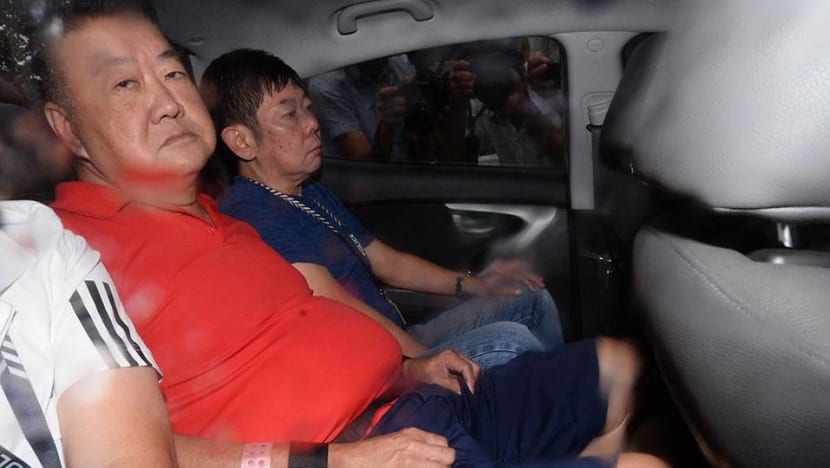Evidence, intention and involvement: AGC, lawyers explain the decisions behind reducing murder charges

Six men and one woman were charged over the Orchard Tower murder case on Jul 4, 2019. (Photo: Hanidah Amin)
SINGAPORE: In July last year, seven people were charged with murder over the death of a man after a brawl at Orchard Towers.
The capital charges were later dropped for six of them. Only the man armed with a knife in the fight faces the murder charge.
Last week, one of the six - 27-year-old Chan Jia Xing - was given a conditional warning for a reduced charge of consorting with the armed man. This means he faces no further developments in the case if he remains crime-free for a year.
Before this, his co-accused Natalie Siow and Joel Tan Yun Sheng received jail terms of five months and four weeks respectively, while Ang Da Yuan was sentenced to eight months' jail and six strokes of the cane.
READ: Woman originally charged with murder in Orchard Towers case gets 5 months' jail on downgraded offences
The case has drawn comments from members of the public questioning the outcome, prompting the Attorney-General's Chambers (AGC) to put out statements clarifying the reduced charges and refuting allegations on social media that claimed the offenders had received preferential treatment in sentencing because of their race.
CNA spoke to the AGC and several lawyers on some key questions - who decides what charge to tender, what goes into a reduction of a charge, as well as how and when charges can be reduced.
WHO DECIDES MURDER CHARGES
Murder is investigated by the Special Investigation Section of the Criminal Investigation Department, said AGC in response to CNA's queries.
The police will tender a holding charge of murder if preliminary investigations indicate that such an offence may be made out against the accused person.
"It is a holding charge because investigations are incomplete and it is necessary for the accused person to be charged and remanded for detailed investigations to be conducted in order to determine if there is sufficient evidence to make out a charge of murder," said AGC.
The accused will also undergo a psychiatric assessment to determine if there is any mental condition. This goes into assessing whether the accused can rely on the partial defence of diminished responsibility, which can lead to the murder charge being reduced to culpable homicide.
Lawyer Suang Wijaya, partner at Eugene Thuraisingam LLP, told CNA that a person may be given a much more serious holding charge than his "final charge", because the exact crime he committed may not be clear at the start of investigations.
Ms Tania Chin, partner of Withers KhattarWong's criminal litigation team, said that the AGC typically takes into account several factors when deciding whether to charge someone with murder.
These include objective evidence seized, such as closed-circuit television footage, weapons and DNA evidence, or crime scene reconstruction. Witness statements and the accused person's statement to the police will also be considered.

Other possible factors include whether the offence was premeditated, the motive or intention of the accused, as well as his extent of involvement, said WongPartnership partner Melanie Ho.
When the police complete their investigations, they will provide their recommendations on the appropriate charge and the proposed course of action to the AGC, which will review the evidence to determine if it is sufficient to prove the holding charge of murder, said AGC.
The public prosecutor's office may also direct the police to conduct further investigations to clarify aspects of evidence or look into other aspects of the case, but ultimately it is the AGC that decides which charge to prosecute the accused person for.
"AGC will first consider whether there is sufficient evidence to prove the holding charge, or any other offence. If there is insufficient evidence to make out the holding charge, the charge will have to be withdrawn or amended to another offence which is supported by the evidence," said the AGC spokesperson.
Even if there is sufficient evidence to make out an offence, the AGC said it will consider whether it would be in the public interest to prosecute, taking into account all relevant facts and circumstances before deciding.
HOW CHARGES ARE REDUCED
The AGC said it can reduce a charge at any point before or during the trial, and the court trying the accused person or hearing an appeal can also amend the charge to a lesser one and convict the accused of the reduced charge.
The prosecution can exercise its prosecutorial discretion to amend or reduce any charge before a trial, said WongPartnership's Ms Ho. If a trial has commenced, the prosecution will have to make an application to the court for any amendment of the charge.
Alternatively, the court may find that the evidence available or heard at trial is insufficient to prove the original charge beyond a reasonable doubt, and therefore frame a different charge, said Ms Ho.
READ: Man originally tried for murder gets jail and caning for slashing cigarette syndicate leader who bled to death
She cited some examples of this, such as the case involving Miya Manik, a Bangladeshi man who was acquitted of murder and given jail and caning for voluntarily causing grievous hurt, as well as the parents of a five-year-old boy who was scalded to death.
The parents, Ridzuan Mega Abdul Rahman and Azlin Arujunah, were acquitted of murdering their son and given 27 years' jail and 24 strokes of the cane and 28 years' jail respectively for voluntarily causing grievous hurt by dangerous means.

Withers KhattarWong's Ms Chin said AGC can reduce charges if evidence uncovered in the course of investigations do not support the elements of the initial charge, and charge reduction could also be done as part of a plea bargaining deal.
When asked what factors go into having a charge reduced, the AGC said it "acts in the public interest".
"Decisions on whether to prosecute, which charge to prefer and what sentence to submit for, are made having due regard to the evidence available and the circumstances of each case, as well as what is fair, measured, and in the public interest," said its spokesperson.
WongPartnership partner Tang Shangwei said factors that may go into deciding whether a charge should be reduced include information or evidence specific to the accused person that may reduce his culpability.
Whether the accused had cooperated with investigations, his conviction history, his age and whether the offence was premeditated or spur-of-the-moment are all possible factors that go into this decision as well, he said.
THE ORCHARD TOWERS CASE
Commenting on the Orchard Towers case, the AGC said holding charges of murder with common intention were initially tendered against the seven accused, who were together as a group when the victim was killed.

"On conclusion of the investigations, the evidence could not make out the offence of murder with common intention against six of them, and their charges were amended based on their involvement in the case. The murder charge preferred against the seventh person, Tan Sen Yang, remains unchanged," said the AGC spokesperson.
In the case of Mr Chan Jia Xing, AGC considered the extent of his involvement, as well as his cooperation with police investigations and the fact that he tried to stop the attack on the victim.
AGC therefore directed the police to issue him with a 12-month conditional warning for his charge of consorting with Tan Sen Yang, who carried an offensive weapon in a public place. This charge had been reduced from murder with common intention.
READ: Man originally charged with murder in Orchard Towers case gets conditional warning for reduced charge
If Mr Chan commits another offence during the 12-month period, he can be charged for the fresh offence and the consorting offence.
Ms Chin said the seven originally accused of murder could have been given those charges at first because initial investigations revealed that they were seen at the murder scene and were involved in some manner with the death.

"However, if further investigations later reveal that their involvement or role was limited, and there was no plan or intention to cause death, then their charges can, and have rightly been reduced," said Ms Chin.
She added: "(This is) normal as the collection and analysis of DNA evidence, the crime scene reconstruction, autopsy reports and the recording of all statements will require some time, and it is the cumulative assessment of all evidence obtained that would have contributed to the decision to reduce the charges of the other six accused persons originally charged with murder."
WongPartnership's Ms Ho said it was likely that evidence uncovered after further investigations pointed to the fact that the six accused did not share the common intention to cause the fatal injury to the victim.
"The reduced charges would be based on their level of involvement in the incident and or whether there are any factors unique to each offender. Such factors would include whether this was their first brush with the law or whether they had similar 'causing hurt' type convictions on their record," said Ms Ho.
CHARGES REDUCED BASED ON MENTAL CONDITIONS
Murder charges can also be reduced based on partial defences to murder, where a defence attempts to distinguish between different levels of control or consciousness that an accused person may have when a killing is committed, said WongPartnership's Mr Tang.
"In the eyes of the law, whilst the killing is wrong, the law views the accused person who was suffering from a mental abnormality as less culpable and less deserving of extreme punishment that one who is in full possession of his faculties," he said.
He referred to the Boon Tat Street case, where the judge found that Tan Nam Seng was suffering from major depressive disorder and was experiencing an episode at the time. His state of mind affected his impulse control and judgment and significantly impaired his mental responsibility for the act. Tan was given eight-and-a-half years' jail last month for a charge of culpable homicide not amounting to murder.

Withers KhattarWong's Ms Chin said AGC could reduce murder charges at an early stage if there is "strong psychiatric evidence linking the accused person's mental condition to the offence and that mental condition would have substantially impaired his mental responsibility for the crime".
AGC said one of the partial defences is commonly known as diminished responsibility. This applies if the accused person's capacity to know the nature and wrongfulness of his acts or his power to control his acts was substantially impaired by his abnormality of mind at the time of the killing.
READ: Justice, mercy and a long road to recovery: An in-depth look at criminals with mental illness in Singapore
In order to determine if the accused can rely on diminished responsibility, he will be remanded at the Institute of Mental Health to be examined by a psychiatrist. The psychiatrist will issue an expert report on the accused person's mental state, and if the AGC is satisfied that there is a clear and proper basis, it can amend a murder charge to a lesser charge of culpable homicide.
Mr Wijaya said that if the AGC does not find that the accused qualifies for the defence of diminished responsibility, the accused can still argue at trial that he qualifies, and if the court agrees, a lower charge can be given.
The differences in lowered charges are in the sentences that can be imposed.
If a person is convicted of murder under section 300a of the penal code, the punishment is death. The punishment for murder under section 300b is death, or life imprisonment with caning, said Ms Ho.
For culpable homicide not amounting to murder, a person can be jailed for life and caned, or jailed for up to 20 years and fined or caned.
If the person committed the killing act knowing it is likely to cause death but without intending to cause death or bodily injury likely to cause death, he can be jailed for up to 15 years, fined, caned, or given any combination of these punishments.
For voluntarily causing grievous hurt by dangerous weapons or means, a person can be jailed for life, or for up to 15 years and caned or fined.
For voluntarily causing grievous hurt, he can be jailed for up to 10 years and fined or caned.














